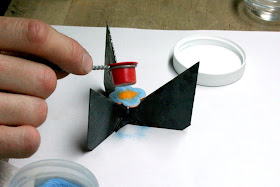 |
| “Over-fired Cuff”' by Emilie Shapiro (vitreous enamel on free-form copper) |
 |
| Sgraffito is a decorative a technique of scratching a wet top layer to create linear designs. |
It helps to have some practical knowledge of metalwork. In this first series of classes, Emilie helped us master the skills and techniques of firing colored glass onto copper by dry-sifting, and wet-packing.
We had our hands full applying layer upon layer yo build a solid opaque surface. Our first project involved sgraffito, an Italian technique in which a design is scratched into a wet layer of enamel to reveal a contrasting color of finished enamel below. It works best with opaque colors.
A copper surface is first cleaned well with denatured alcohol, then buffed dry and treated with Klyr-fire, a cellulose adhesive. Traces of hand grease and impurities affect how well the color covers as it is heated. In this lesson powdered glass is applied by sifting evenly onto the treated surface. Multiple colors can be applied to created an organic gradation but it's best not to blend a new color with this method.
Of course my favorite part of this class was Torch Firing with an acetylene torch. Isn’t that every boy’s dream? This is the most practical way to learn how different materials react to high concentrated heat (“high fire”). You literally can watch metal and glass melt and oxidize. If you're not careful you might melt your project to the trivet — I learned that the hard way.
Work carefully and quickly. As you wait for the copper to turn a bright shade of orange you must also watch the texture of the glass as it fuses. The powdered glass first takes on the texture of granulated sugar as you move the torch around from below. It’s finished when it takes on orange peel texture. When glass is heated to the point of burning it’s called “over-firing.” This effect is similar to raku pottery.
The finished enamel is moved to a clay surface to cool, then is pickled in a low acid bath. More layers can be applied to create different effects as you can see from the examples we made in this class.
Copper is a great conductor of heat, it also has a lower melting point than the steel trivet used for support. Other types of metal for enamelware are fine gold, and sterling silver.
In this studio class we gained a practical knowledge of all tool sand materials for working with enamel. This class has been nothing less than fascinating, but there’s still so much more to learn. Perfecting these techniques lead us to the making cloisonné jewelry. Cloisonné is a Far Eastern technique refined by the French. The word “cloison” is French for partition. This enamel technique involves inlaying different colors into separate compartments made from thin strips of wire. It resembles a painting made from jewels.
 |
| In this class I enameled copper buttons to look like mother of pearl and other oxidized metals, clever no?. |
To learn more about precious metal and and jewelry making workshops at Liloveve Studio, and to see Caroline Glemann’s work visit her studio website: www.liloveve.com.
Emilie Shapiro is contemporary jewelry designer and metalsmith who received her BFA in Art & Design from Syracuse University. She has studied at Alchimia, a contemporary school of Italian jewelry in Florence, with artist Peter Bauhuis. She managed production at Pamela Love and Allforthemountain and has since launched her own line of jewelry and body adornment. To see more of Emilie Shaprio’s work, visit her website: www.emilieshapiro.com.








Not related to jewelry-making, but related to torches... The most fun part of making stock for pho is pulling out the torch to sear the bejeezus out of the onions and ginger. SO MUCH FUN!
ReplyDeletei love that torch! I think everyone should have a torch at home... except for the pyros.
ReplyDeletehi really lime your work, just wondering about class schedules and costs. thanks.
ReplyDelete